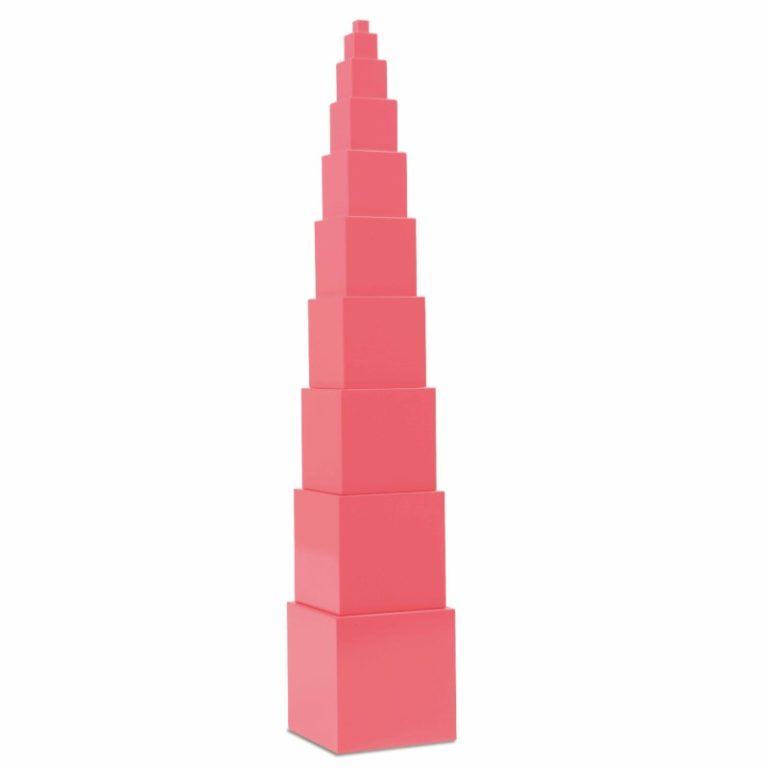
The Pink Tower is the iconic Montessori material. Often called the ‘symbol of Montessori’, it is a welcoming sign in any Montessori primary environment and a favorite with educators globally.
This series of cubes develops visual discrimination of size in three dimensions.
Exploration with this material prepares the child for mathematical concepts in the decimal system, geometry, and volume.
The Pink Tower
The Pink Tower consists of ten wooden cubes painted pink, increasing incrementally from 1 cm³ to 10 cm³. The cubes progressively get bigger in the algebraic series of the third power. This means the second cube equals 8 of the first (2cubed), the third cube equals 27 of the first (3cubed), and so on.
The Pink Tower is introduced to children 2.5 to 3 years old and is one of the first materials primary children are shown. The Pink Tower is part of the sensorial area and has multiple purposes.
First, the Pink Tower helps a child build a concept of size in three dimensions. This includes working on visual perception and awareness of dimension, both leading to an understanding of size in the environment. The Pink Tower also helps develop a child’s fine muscular coordination. The physical actions stemming from this material aid in the development of hand coordination and the coordination of movement.
Finally, the Pink Tower is a Montessori material that helps prepare children for abstract mathematical concepts. This includes preparation for spatial volume and the cube root.
The Pink Tower is a perfect example of how Montessori materials require children to use multiple senses at once. They are created in such a way to complement a child’s stage of development where they use all their senses to learn.
Initial Presentation of the Pink Tower
1) Roll out a mat as your workstation.
2) Invite the child to the sensorial area and identify the pink tower.
3) Starting at the top, with the smallest cube, pick up one at a time, with one hand on top and one hand underneath. Carry the cubes to the mat and arrange them randomly on the mat.
4) Once all the cubes are on the mat, sit on the child’s dominant side.
5) Begin to construct the Pink Tower, by picking up the largest cube with fingertips of each hand on either side of the cube.
6) From time to time, stop and pause to compare a cube to the next smallest one to make certain you chose the appropriate next cube. Also, take time to center using a bird’s eye view as your measure.
7) When the tower is complete, check centering using a bird’s eye view once again.
8) Randomize the cubes again and offer the child a turn. Remember they will make mistakes at first, but will gradually perfect the ability to judge size with practice.
Extension
Once the child has mastered building the tower, invite them to use the Pink Tower in conjunction with the Brown Stairs.
Purpose
- Direct visual discrimination of dimensions.
Indirect Purposes
- Refinement of voluntary movement by placing the cubes one on top of the other with one single movement of the hand. While doing this movement, the child is refining visual-motor coordination and is called upon to concentrate.
- Preparation for mathematics.
Control of Error
- The control of error lies within the child being able to discriminate dimensions.
- Visual harmony.